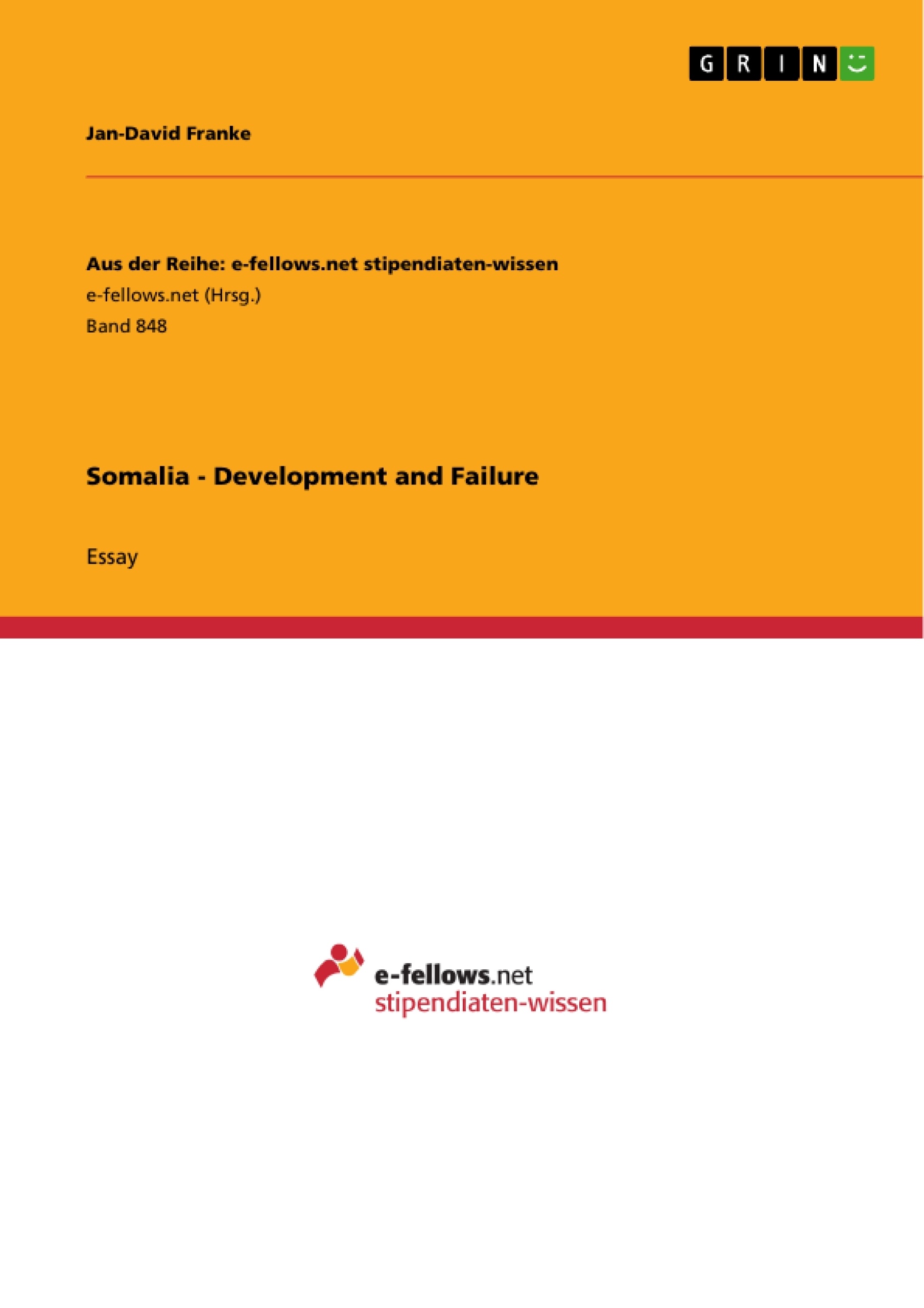Somalia is a country in the East of Africa, situated at the horn of Africa with a population of ca. 9.3 million (BTI 2012). In this part of the world, life is hard (e.g. infant mortality rate: 10%) and short (life expectancy at birth: 51 years). “Freedom in the World 2012” by Freedom House gives Somalia the worst possible rating both for political rights and civil liberties. It ranks at place 223 of 227 in terms of GDP per capita (CIA Factbook, 2012). The Global Peace Index lists Somalia as the most dangerous country in the world while the Transitional Federal Government of Somalia (TFG), which is supported by the United Nations, the African Union and the United States, merely controls parts of the capital Mogadishu (Bruton, 2009). Around 40% of Somali territory is occupied by a radical muslim militia called Al-Shabab. The famine that befell the horn of Africa in 2011 struck Somalia worst, a country, which is mostly referred to as a ‘failed state’ for 20 years now. The situation in Somalia, so much is clear, is very serious and appalling in a variety of fields. But why is that?
In this paper I will describe Somalia’s recent development in the framework introduced by Szirmai (2005: pp. 29-33), using his 9 characteristics of developing countries for classification, and - building up on that - inquire into possible explanations for its deficiencies and its failure as a state.
Inhaltsverzeichnis (Table of Contents)
- WIDESPREAD POVERTY AND MALNUTRITION
- A RELATIVELY LARGE SHARE OF AGRICULTURE IN OUTPUT AND EMPLOYMENT
- The 'agricultural productivity gap'
- PRONOUNCED DUALISM IN ECONOMIC STRUCTURE
- Technological Dualism
- Regional Dualism
- HIGH LEVELS OF ILLITERACY AND LACK OF ACCESS TO EDUCATION
- Consequences of the lack of education
- WEAK INFRASTRUCTURE AND HIGH TRANSPORTATION COSTS
- Consequences of weak infrastructure
- HIGH LEVELS OF CRIME AND VIOLENCE
- Consequences of crime and violence
- LIMITED ACCESS TO HEALTH CARE
- Consequences of limited access to health care
- HIGH POPULATION GROWTH RATE
- Consequences of high population growth rate
- A SIGNIFICANT NUMBER OF REFUGEES AND INTERNALLY DISPLACED PERSONS
- Consequences of refugees and internally displaced persons
- LACK OF EFFECTIVE GOVERNANCE
- Consequences of lack of effective governance
- CORRUPTION AND NEPOTISM
- Consequences of corruption and nepotism
- A WEAK CIVIL SOCIETY
- Consequences of a weak civil society
- EXTERNAL DEPENDENCE AND INTERNATIONAL INTERVENTION
- Consequences of external dependence and international intervention
Zielsetzung und Themenschwerpunkte (Objectives and Key Themes)
The paper examines the recent development of Somalia by analyzing its shortcomings and failure as a state. It draws upon the framework developed by Szirmai (2005), employing his 9 characteristics of developing countries for classification. The paper explores potential explanations for Somalia's deficiencies, particularly its political instability and widespread poverty.- Somalia's socio-economic challenges, including poverty, malnutrition, and limited access to essential services.
- The impact of agriculture on Somalia's economy and the "agricultural productivity gap" phenomenon.
- Dualism in Somalia's economic structure, encompassing technological and regional variations.
- The role of education, infrastructure, and governance in contributing to Somalia's development failures.
- The influence of external factors, such as international intervention and dependence, on Somalia's progress.
Zusammenfassung der Kapitel (Chapter Summaries)
The first chapter explores the pervasive poverty and malnutrition in Somalia. It discusses the Socio-Economic Survey on Somalia (2002) and the Multidimensional Poverty Index (MPI), highlighting the high rates of deprivation and their impact on the Somali population. The chapter further examines the devastating famine that struck Somalia in 2011, emphasizing its detrimental effect on the country's nutritional status. The second chapter delves into the significance of agriculture in Somalia's economy and labor market. It discusses the dominance of the primary sector and the "agricultural productivity gap," illustrating how dependence on agriculture can lead to vulnerability and economic instability. The chapter emphasizes the need for diversification and modernization of the agricultural sector for sustainable development. The third chapter focuses on the pronounced dualism in Somalia's economic structure. It contrasts the economic conditions in urban and rural areas, highlighting the disparities in access to resources and opportunities. The chapter also examines the implications of this dualism for income inequality and socio-economic development. The fourth chapter investigates the high levels of illiteracy and lack of access to education in Somalia. It explores the consequences of limited educational opportunities, such as decreased economic productivity and social mobility. The chapter stresses the need for investments in education and human capital development to foster long-term economic growth. The fifth chapter delves into the weak infrastructure and high transportation costs in Somalia. It examines the implications of insufficient infrastructure on the country's economic development and the challenges faced by businesses and individuals. The chapter highlights the need for improved infrastructure, particularly in the areas of transportation, energy, and communication, for sustainable growth.Schlüsselwörter (Keywords)
The main keywords and focus topics of this paper include: Somalia, development, failure, poverty, malnutrition, agriculture, dualism, education, infrastructure, governance, external dependence, international intervention, and conflict. These terms encapsulate the core themes and concepts explored in the text, providing insights into the complex challenges facing Somalia and its potential for development.- Quote paper
- Jan-David Franke (Author), 2012, Somalia - Development and Failure, Munich, GRIN Verlag, https://www.grin.com/document/264808



